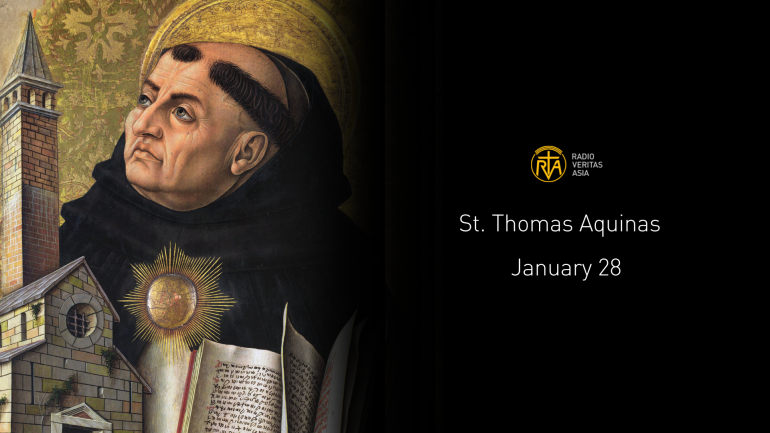St. Thomas Aquinas

A Dominican friar, philosopher, scholar, and theologian, the feast day of St. Thomas Aquinas, is observed every January 28. He is a patron of students and all universities.
Born in 1225 to well-off parents in what is now known as the Lazio region of Italy, he died in 1274 and was canonized by Pope John XXII in 1323.
His work has had a lasting impact on the Catholic Church and Western philosophy.
His original feast day was March 7 when he died. But since it usually falls within Lent, in 1969, this was revised in the Roman Calendar to Jan. 28, his relics were moved to Toulouse.
Pope Pius V declared Saint Thomas a doctor of the church: "the most brilliant light of the Church."
He began school at age 5. His influences include Aristotle at the university where he also met John of St. Julian, a Dominican preacher, who also inspired him to join the Dominican Order.
He had challenges in his vocation earlier on. When he showed interest in priesthood which his family did not like. For one year, he was kept in the castle but it did not stop him from communicating with members of the Dominican Order.
His family tried to take him away from his vocation like two of his brothers hired a prostitute to seduce him. But legends said Thomas succeeded in shying them away with a fire iron and in the evening, he saw in his dream two angels which even strengthened his option for celibacy.
When his mother, Theodora, saw that Thomas was firm on his decision, she arranged his escape in 1244 through a window because she believed that was better than appearing to accept his decision.
Thomas turned to Naples, then Rome, and met the Master General of the Dominical Order, Johannes von Wildeshausen. The following year, Thomas went to study at the Faculty of the Arts at the University of Paris, where he is believed to have met Dominican scholar Albertus Mangus, the Chair of Theology at the College of St. James.
Thomas was quiet and seldom spoke at the university, leading other students to believe he was mentally delayed, but Mangus prophetically said, "You call him the dumb ox, but in his teaching, he will one day produce such a bellowing that it will be heard throughout the world."
In 1252, Thomas returned to Paris to earn his master's degree in theology. Later on, he wrote several books, including one of his most famous works, Summa contra Gentiles, which was useful to beginning students.
One of Aquinas’s greatest contributions was his ability to reconcile reason with faith, showing that philosophy and theology can lead to the same truths.
Towards the end of his regency, the Dominicans called Thomas to establish a university wherever he wanted with a staff of whomever he wished. He established the university in Naples and took the regent master's post.
In 1273 Thomas was seen by the sacristan Domenic of Caserta to be crying and levitating in prayer before an icon of the crucified Christ at the Dominican convent of Naples, in the Chapel of Saint Nicholas.
During this prayer, Christ is said to have spoken to him, "You have written well of me, Thomas. What reward would you have for your labor?" He replied, "Nothing but you, Lord."
In May of 1274, Thomas was said to have been called to the Second Council of Lyon, where his works for Pope Urban IV would be presented. While journeying to the meeting, Thomas hit his head on the branch of a fallen tree and fell ill. He was escorted to Monte Cassino to recover, then he set out again.
But he became sick again and stopped at the Cistercian Fossanova Abbey, where he was taken care of by the monks for a number of days.
He received his last rites and prayed, "I receive Thee, ransom of my soul. For the love of Thee have I studied and kept vigil, toiled, preached and taught..."
Thomas died on March 7, 1274. His remains were placed in the Church of the Jacobins in Toulouse on January 28, 1369. On July 18, 1323, Pope John XXII canonized him.
In the 16th century, the university in Paris, where Thomas often taught, was renamed the College of Saint Thomas, and in the 20th century, it was relocated to the convent of Saints Dominic and Sixtus before being transformed into the Pontifical University of Saint Thomas Aquinas.
Saint Thomas is often depicted with an open book or writing with a quill.
One of Aquinas’s greatest contributions was his ability to reconcile reason with faith, showing that philosophy and theology can lead to the same truths.
Radio Veritas Asia (RVA), a media platform of the Catholic Church, aims to share Christ. RVA started in 1969 as a continental Catholic radio station to serve Asian countries in their respective local language, thus earning the tag “the Voice of Asian Christianity.” Responding to the emerging context, RVA embraced media platforms to connect with the global Asian audience via its 21 language websites and various social media platforms.












